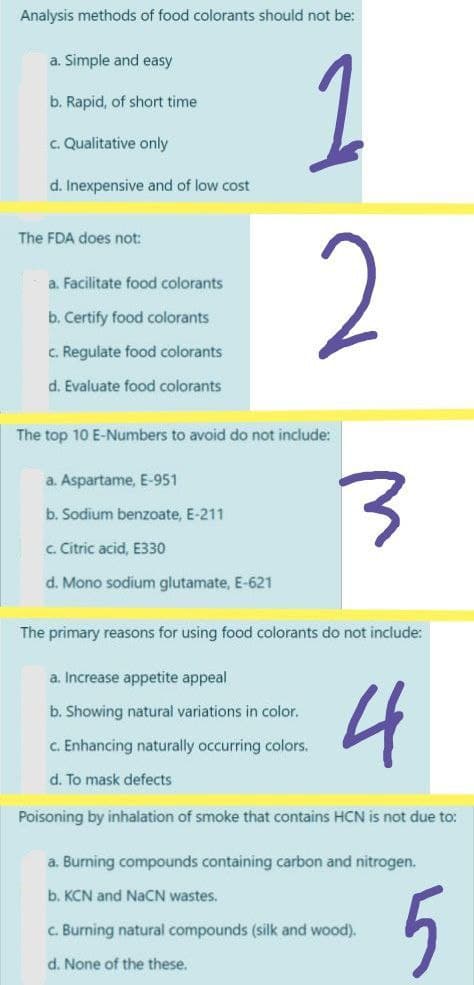Analysis methods of food colorants should not be: a. Simple and easy 1 b. Rapid, of short time c. Qualitative only d. Inexpensive and of low cost The FDA does not: a. Facilitate food colorants h Certify food colorants
Analysis methods of food colorants should not be: a. Simple and easy 1 b. Rapid, of short time c. Qualitative only d. Inexpensive and of low cost The FDA does not: a. Facilitate food colorants h Certify food colorants
Chemistry: The Molecular Science
5th Edition
ISBN:9781285199047
Author:John W. Moore, Conrad L. Stanitski
Publisher:John W. Moore, Conrad L. Stanitski
Chapter13: The Chemistry Of Solutes And Solutions
Section: Chapter Questions
Problem 57QRT
Related questions
Question

Transcribed Image Text:Analysis methods of food colorants should not be:
1
a. Simple and easy
b. Rapid, of short time
c. Qualitative only
d. Inexpensive and of low cost
The FDA does not:
2
a. Facilitate food colorants
b. Certify food colorants
C. Regulate food colorants
d. Evaluate food colorants
The top 10 E-Numbers to avoid do not include:
a. Aspartame, E-951
b. Sodium benzoate, E-211
c. Citric acid, E330
d. Mono sodium glutamate, E-621
The primary reasons for using food colorants do not include:
a. Increase appetite appeal
4
b. Showing natural variations in color.
C. Enhancing naturally occurring colors.
d. To mask defects
Poisoning by inhalation of smoke that contains HCN is not due to:
a. Burning compounds containing carbon and nitrogen.
5
b. KCN and NaCN wastes.
c. Burning natural compounds (silk and wood).
d. None of the these.
Expert Solution
This question has been solved!
Explore an expertly crafted, step-by-step solution for a thorough understanding of key concepts.
Step by step
Solved in 4 steps with 4 images

Knowledge Booster
Learn more about
Need a deep-dive on the concept behind this application? Look no further. Learn more about this topic, chemistry and related others by exploring similar questions and additional content below.Recommended textbooks for you

Chemistry: The Molecular Science
Chemistry
ISBN:
9781285199047
Author:
John W. Moore, Conrad L. Stanitski
Publisher:
Cengage Learning

Chemical Principles in the Laboratory
Chemistry
ISBN:
9781305264434
Author:
Emil Slowinski, Wayne C. Wolsey, Robert Rossi
Publisher:
Brooks Cole

Chemistry for Today: General, Organic, and Bioche…
Chemistry
ISBN:
9781305960060
Author:
Spencer L. Seager, Michael R. Slabaugh, Maren S. Hansen
Publisher:
Cengage Learning

Chemistry: The Molecular Science
Chemistry
ISBN:
9781285199047
Author:
John W. Moore, Conrad L. Stanitski
Publisher:
Cengage Learning

Chemical Principles in the Laboratory
Chemistry
ISBN:
9781305264434
Author:
Emil Slowinski, Wayne C. Wolsey, Robert Rossi
Publisher:
Brooks Cole

Chemistry for Today: General, Organic, and Bioche…
Chemistry
ISBN:
9781305960060
Author:
Spencer L. Seager, Michael R. Slabaugh, Maren S. Hansen
Publisher:
Cengage Learning

Introduction to General, Organic and Biochemistry
Chemistry
ISBN:
9781285869759
Author:
Frederick A. Bettelheim, William H. Brown, Mary K. Campbell, Shawn O. Farrell, Omar Torres
Publisher:
Cengage Learning

Chemistry In Focus
Chemistry
ISBN:
9781305084476
Author:
Tro, Nivaldo J., Neu, Don.
Publisher:
Cengage Learning